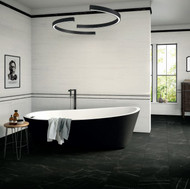Bathroom Tile you will love in 2021
Posted by Mike Belk on Apr 26, 2021

The bathroom is one of the most intimate, personal rooms in a house. It should be a fun and relaxing personal space that also shows character. For this reason, your taste and style should show through the décor, such as with bathroom tiles.
So if you’re looking for inspiration on how to turn your old bathroom from drab to fab, you’ve come to the right place!
What are Tiles?
Tiles are thin pieces of square or rectangle-shaped plates. They’re used to cover different areas of the house. They can be made from different materials such as ceramic, stone, glass, or metal.
Tiles have been around since 13 th century BC. They were more common in the Middle Eastern civilizations than in the west. Ancient Mesopotamians used colored bricks to decorate gates and temple walls. Ancient Indian houses had floors tiled with clay. In ancient Sri Lanka, polished stone tiles were used to line swimming pools.
Today, tiles are used widely around the world. They’re used on roofs, floors, walls, and even on ceilings. They’re used both for practical and aesthetic purposes.
Why Use Tiles in the Bathroom?
There are many reasons why tiles are exceptionally great in bathrooms. Here are some of them:
- Tiles are resistant to water.
In a room where splashes and spills are common, you’ll definitely need walls and floors that are resistant to them. Unlike hardwood floors and decorative wallpaper, tiles repel water so you can use them all around your bathroom.
Water in itself isn’t the problem. You can also easily wipe off water from treated hardwood or laminates. However, a constantly wet environment such as a bathroom is the perfect breeding ground for mold and mildew.
Moisture can soak between and underneath the bindings and adhesives. It can soften and dislodge glue, which makes old wallpaper peel, buckle, and warp. These moist areas are where mold love to thrive, which can make an untiled bathroom an unhygienic place.
2. Tiles are easy to clean and disinfect.
Tiles are also easier to clean than most surfaces. You simply need to wipe them clean. You can also use a wide variety of cleaners to disinfect tiles. This is why many hospitals use tiles in their operating rooms.
Can you imagine a bathroom fitted with carpets all over the floors? Not only is it a pain to clean and maintain, it’s also unhygienic. Water soaked up by the carpet fibers can’t fully dry in that moist environment, making it a perfect breeding ground for all sorts of bacteria and fungi. You’d have to constantly wash and disinfect your carpets.
But with bathroom tiles, all you need is a rag or sponge and a bottle of cleaner
3. Great for radiant heating.
If you live in an area that has winter, you’ll appreciate bathroom tiles. They’re great for radiant heating technology. An elegant stone tile in particular ends up cooler during the hot months and warmer during the colder months. Just imagine taking a hot shower in winter and stepping unto an ice-cold floor afterwards. With stone tiles, that won’t be a problem.
4. They’re durable.
Another problem countries with four seasons might face is durability. All things expand in heat and contract in cold. It’s why some materials crack or warp over time.
Ceramic and stone tiles are particularly durable for long-term use. Even if your bathroom cycles between hot and cold regularly, ceramic and stone tiles won’t crack or break that easily.
What are the Different Kinds of Bath Tiles?
There are many kinds of tiles you can use in the bathroom. Here are some of the most popular ones, along with the pros and cons:
- Ceramic
Ceramic tiles are glazed tiles made from clay, stone, or even recycled glass.
Pros:
Cons:

2.
Terracotta
Terracotta tiles are like ceramic
in that they’re both made from clay. However, terracotta is heated at a lower
temperature than ceramic.
Because terracotta is closely related to ceramic, it shares many of its pros and cons.
Pros:
Cons:
3. Vinyl
Vinyl tiles are made from solid sheets of PVC, a durable plastic polymer. Because vinyl is cheaper to make than ceramics, vinyl tiles are cheaper and are preferred by many.
Pros:
Cons:
4. Stone
Stone tiles can be made from limestone, granite, marble, and slate.
The pros and cons of stone tiles depend on the kind of stone they’re made of.
A. Marble
Pros:
Cons:

B.
Granite
Pros:
Cons:
C. Limestone
Pros:
Cons:
D. Slate
Pros:
Cons:
5. Glass
Glass brings a distinct visual appeal to rooms. This is perfect if you want a more delicate aesthetic. One of the newer tile trends is the glass subway tiles look, which is perfect for those who want a clean and minimalistic design.
Pros:
Cons:
6. Linoleum
Linoleum can come in sheets and can be installed in huge batches. Linoleum can also come in liquid form.
Pros:
Cons:
Best Tile Designs for Your Bathroom
Now that you have an idea of the kind of tile you want, it’s time to think of the design.
Tile design doesn’t just mean the look of the single tile. It can also mean the pattern that the tiles make after laying them down.
Because tiles can be cut in rectangles or squares, you can create interesting patterns and designs on your walls and floors. Here are some of the more popular ones:
- Bands (Brick Style)
This is the most common tile pattern. You see it in many places all the time. In fact, the NYC subway look that uses beveled subway tiles is laid out in a brick-style band pattern.

Bands can be laid out in columnar or alternating patterns. Columnar means the edges align with each other. With alternating, you’ll want to offset the alignment of every other band of tiles.
2. Herringbone
Herringbone refers to a v-shaped pattern made when inlaying tiles. It creates a fishbone look. It’s a very stylish tile pattern that’s a staple in many tile shops and decorator catalogues.
Herringbones can also differ in terms of angle. You can from a 45-degree herringbone to a 90-degree herringbone.

You can choose to use herringbone all over your bathroom or in just a section to serve as a focal point. Try herringbone tile in the shower for a stylish yet classy design choice.
3. Square
Not to be confused with square-cut tiles, a square pattern is when you take the rectangular tiles and lay them out to form squares.

4. Basketweave
Basketweave is a pattern made when you alternate the tiles between horizontal and vertical. This is the basic concept but you can play around the design by choose the number of rows or columns to use for each weave.

These are some of the most common tile patterns you can try.
Things to Consider When Choosing Bathroom Tiles
Once you’ve decided on the kind of tile and pattern, it’s time to get to the nitty-gritty. You have to think about a few other things before you head out and buy your tiles.
First, is to think about the size of your bathroom. And yes, this means actually measuring the walls and floor. You’ll need to know the dimensions to have an idea of how many tiles should fit and what size the tiles should be.
Also think about the size of the bathroom in general. Is it small? If so, smaller cut tiles might be more suitable for you. On the other hand, using larger tiles in a smaller space can give the illusion of space. Think about the different effects and look at photos for inspiration online.
The next thing to consider is where the tiles will end up. While some kinds of tiles are suited for both walls and floors, it’s best to be specific on where the tiles will go when buying them. This is because floor tiles are glazed with a harder material so they can withstand the daily wear of heavy foot traffic. If you use wall tiles on your floor, you can expect them to wear out faster.
Next, you must also consider the lighting in your bathroom. Do you use harsh lights? Frosted lights? Natural lighting?
Some tiles look better under certain lighting conditions. For example, glossy tiles are great for bathrooms with subdued lighting because they will reflect what little light there is.
After that, you should also consider the color grout you’ll use. White will make the designs and patterns pop, while a softer muted color will make the lines segments look more invisible.
Another thing you should consider is having a Plan B and C. What will you do if the dream tile and pattern you desperately want is unattainable? For instance, if the final quote is way over your budget, or if the design can’t be replicated with your bathroom’s dimensions?
If this is the scenario, it’s best for you to have come prepared with a secondary and tertiary option.
Lastly, do your rounds and ask or buy tile samples from shops. Sometimes shops have rough cuts from tile ends that they can give away for free. Otherwise, you can buy a sample tile to take home with you.
Why is this important? Because the tile you loved in an online photo or inside the shop might look different inside your own bathroom. Sometimes the color will clash with the lighting, or the design will fight with the other décor. If you take a tile sample and take it home with you, you can see first hand if your choice will suit your final design.
In Conclusion
Tiles have been used as a practical and aesthetic way to cover walls, roofs, and floors for thousands of years. There’s a reason why tiles are still used today in modern houses.
Tiles are your best bet when it comes to bathrooms. They’re the first pick because they’re resistant to water splashes, stains, and mold and mildew. Cleanup and disinfection are also easier compared to other types of wall covers and floorings.
With this comprehensive guide to bathroom tiles, you’ll surely find one you’ll love. Get started with redecorating your personal space today!



